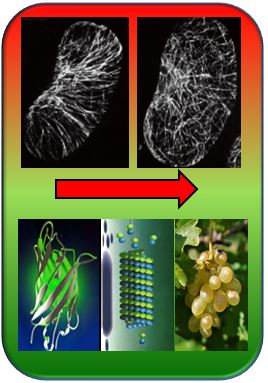The Cytoskeleton as Signal-Processor in Stress Adaptation
What is the topic of this research?
The cytoskeleton of animals mediates movement, shape and division and thus has mainly structural functions. In plants, cell shape is maintained through the cell wall and cellular movements do not exist. Thus, the cytoskeleton has adopted novel functions, for instance in processing of signals. We think therefore that the cytoskeleton is important for the „Grammar of Stress-Signalling“.
How did this idea originate?
To observe the cytoskeleton in the run,, we have generated grapes, where certain components of the cytoskeleton are illuminated by means of fluorescent jellyfish. This allows to follow the cellular response to signals in real time. For instance, we have found that microtubules act as thermometer, controlling cold resistance, whereas actin filaments in guard cells participate in the recognition of attacking microbes and generate a signal that alarms the neighbouring cells.
What is our vision?
The cytoskeleton as dynamic tool offers many opportunities to manipulate plants in a targeted and subtle manner - may it be through novel compounds, may it be through breeding, may it be through physical approaches (so called priming). The potential for a sustainable agriculture has not even be partially addressed. Since the lever are signals and since signals draw their specificity from the context, it is possible to develop very specific strategies and to minimise undesired side effects upon other organisms.
Individual projects
- Microtubules as thermometer
- Microtubules and stress tolerance of rice. more...
- Actin filaments as sensors for pathogen attack

